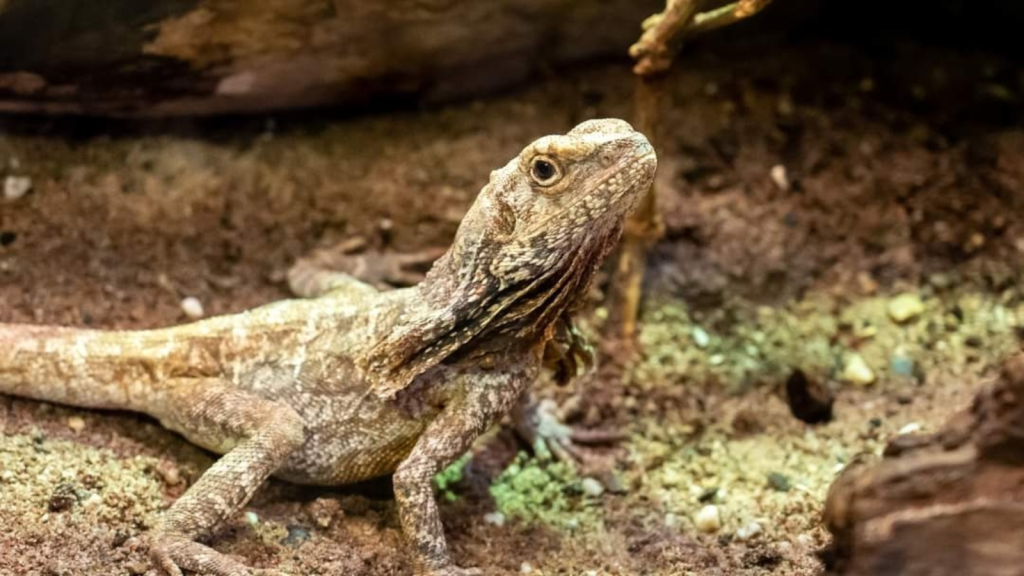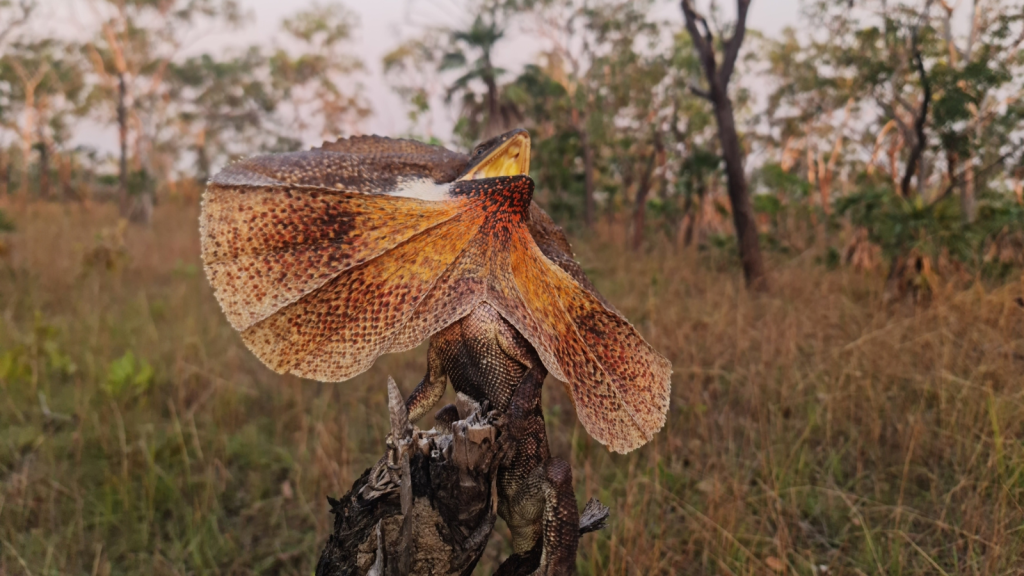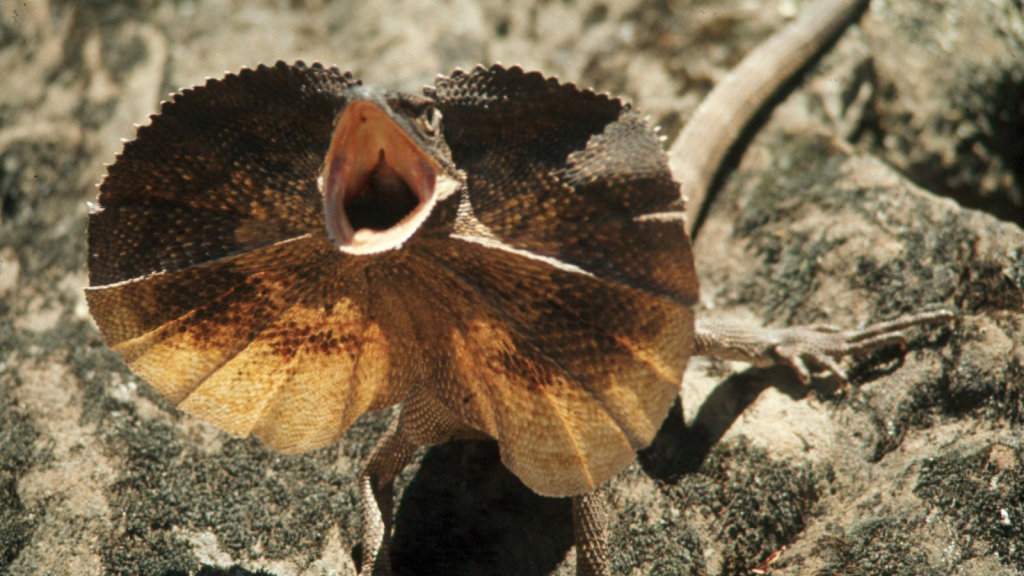Picture a lizard with a collar fit for a Shakespearean play. That’s the frill-necked lizard, a creature that seems to have leapt straight from the pages of a fantasy novel. These remarkable reptiles, native to northern Australia and southern New Guinea, are more than just their eye-catching neck frill. They’re agile tree-dwellers, crafty hunters, and masters of bluff. From their prehistoric appearance to their modern-day challenges, frill-necked lizards captivate the imagination and spark wonder in nature lovers worldwide. Ready to expand your reptile knowledge? Here are 18 fantastic facts about these marvellous creatures.
A Living Dinosaur Look-Alike

The frill-necked lizard’s appearance is strikingly similar to the small carnivorous dinosaur Dilophosaurus. This resemblance isn’t just skin-deep; both share a similar neck frill structure. However, the lizard’s frill is made of skin and cartilage, while the dinosaur’s was likely bony. This uncanny likeness makes the frill-necked lizard a favourite among dinosaur enthusiasts and herpetologists alike. Interestingly, the lizard’s scientific name, Chlamydosaurus kingii, translates to “King’s cloak lizard,” further emphasizing its regal, dinosaur-like appearance.
Masters of Disguise

These lizards are experts at blending in with their surroundings. Their body colour can range from grey to brown, perfectly matching tree bark. Some even sport reddish-orange hues to blend with the rusty soils of the Australian Outback. This camouflage isn’t just for show – it’s a vital survival strategy that helps them avoid predators and sneak up on prey. The lizards can also change their colour slightly to better match their environment, although not as dramatically as chameleons.
The Famous Frill

The lizard’s most distinctive feature, its frill, is usually folded back against its body. When threatened, the lizard erects this frill, which can be up to 25 centimetres in diameter. The sudden appearance of this large, brightly coloured disc often startles predators, giving the lizard precious seconds to escape. It’s a remarkable example of natural intimidation tactics. The frill is supported by long spines of cartilage connected to the jaw, allowing the lizard to snap it open in a fraction of a second.
Two-Legged Sprinters

When fleeing danger, frill-necked lizards can run on their hind legs. This bipedal sprint can reach speeds of up to 13 kilometres per hour. It’s a sight to behold – imagine a mini dinosaur dashing across the Australian bush on two legs! This ability not only helps them escape predators but also allows them to cover ground quickly when hunting insects. Their long, powerful hind legs and counterbalancing tail make this unusual form of locomotion possible.
Tree-Dwelling Acrobats

Frill-necked lizards are arboreal, meaning they spend most of their time in trees. They’re incredibly agile climbers, using their long toes and sharp claws to grip bark. These lizards can often be spotted basking on branches or scurrying up and down tree trunks with impressive speed and grace. Their flattened bodies also help them hug close to tree trunks, providing better camouflage and stability when climbing.
Heat-Loving Sunbathers

Like many reptiles, frill-necked lizards are ectothermic, relying on external sources for body heat. They’re often seen basking in the sun, especially in the morning. This behaviour helps them warm up and become active for the day ahead. During the hottest parts of the day, they’ll seek shade to avoid overheating. Their ability to regulate body temperature through behaviour is crucial for survival in the extreme heat of their native habitats.
Insectivorous Diet

Frill-necked lizards are primarily insectivores. Their diet consists mainly of insects like beetles, termites, and ants. They’re also known to eat small vertebrates occasionally. These lizards are sit-and-wait predators, often remaining motionless for long periods before striking quickly at passing prey. Their excellent eyesight helps them spot tiny insects from a distance, making them efficient hunters.
Unique Dental Arrangement

Unlike many lizards, frill-necked lizards have teeth that are fused to the top of their jaws, a condition known as acrodont dentition. This dental structure is well-suited for their insectivorous diet. It allows them to crush the hard exoskeletons of beetles and other insects effectively. However, this type of dentition means they can’t replace lost or worn teeth, unlike some other reptiles.
Seasonal Breeders

Breeding season for frill-necked lizards typically occurs during the wet season, from September to October. Males become territorial during this time, showing off their frills to intimidate rivals and attract females. The vibrant colours of their frills become even more pronounced during the breeding season. Females are selective in their choice of mates, often preferring males with larger, more colourful frills.
Egg-Laying Reptiles

Female frill-necked lizards are oviparous, meaning they lay eggs rather than giving birth to live young. A typical clutch consists of 8-23 eggs, which are buried in the ground. The eggs incubate for about two months before hatching. The young lizards are independent from birth, already equipped with their miniature frills. The mother doesn’t provide any parental care after laying the eggs, leaving the hatchlings to fend for themselves.
Longevity in the Wild

In their natural habitat, frill-necked lizards can live up to 20 years. However, their lifespan in the wild is often shorter due to predation and environmental challenges. In captivity, with proper care, they’ve been known to live even longer, sometimes reaching 25 years or more. Their longevity is influenced by factors such as diet, habitat quality, and exposure to predators.
Size Matters

Adult frill-necked lizards typically grow to about 85 centimetres in total length, with their tail accounting for about two-thirds of this. Males are generally larger than females, often with more prominent frills. Despite their impressive size, they’re not the largest lizards in Australia – that title belongs to the perentie, a type of monitor lizard. The size difference between males and females is an example of sexual dimorphism, common in many reptile species.
Vocalisation Abilities

While not as vocal as some other reptiles, frill-necked lizards can produce a range of sounds. When threatened, they may hiss loudly as part of their defensive display. They also make softer clicking noises during social interactions. These vocalisations, combined with visual displays, form an important part of their communication repertoire. The hissing sound is produced by forcefully expelling air from their lungs, adding to their intimidating display.
Frill Functionality

The frill isn’t just for show or defence. It also plays a role in temperature regulation. The lizard can increase blood flow to the frill, using it as a sort of radiator to cool down when temperatures soar. This adaptation is particularly useful in the hot, arid regions where many frill-necked lizards live. The frill’s large surface area relative to the lizard’s body size makes it an effective tool for thermoregulation.
Cultural Significance

Frill-necked lizards hold a special place in Australian culture. They’ve been featured on postage stamps and even appeared on the defunct two-cent coin. In some Aboriginal Dreamtime stories, these lizards are portrayed as wise and respected creatures. Their unique appearance has made them iconic symbols of Australia’s diverse wildlife. The lizard’s image is also popular in Australian tourism, often used to represent the country’s unique fauna.
Habitat Loss Challenges

Like many species, frill-necked lizards face threats from habitat loss due to human activities. Deforestation and bush fires pose significant risks to their populations. Conservation efforts are underway to protect their habitats and ensure the survival of these remarkable reptiles for future generations to marvel at. Climate change also presents a growing threat, potentially altering the landscapes these lizards depend on.
Adaptable Survivors

Despite challenges, frill-necked lizards have shown remarkable adaptability. They can be found in various habitats, from tropical forests to drier woodland areas. This adaptability has helped them survive in changing environments. However, they still require specific conditions to thrive, making habitat conservation crucial. Their ability to live in different types of forests and woodlands has allowed them to maintain a relatively wide distribution across northern Australia.
Scientific Marvel

Researchers continue to study frill-necked lizards, uncovering new insights about their behaviour and biology. Recent studies have focused on the biomechanics of their bipedal running and the evolution of their frill. These lizards serve as fascinating subjects for understanding reptile evolution and adaptation in challenging environments. Ongoing research also explores their potential as indicators of ecosystem health in their native habitats.
15 Terrifying Prehistoric Creatures That Aren’t Dinosaurs

When we think of prehistoric beasts, dinosaurs often come to mind first. But the ancient world was filled with many other terrifying creatures that would give even the fiercest dinosaurs a run for their money. Let’s dive into the murky waters and dense forests of prehistory to meet some of these nightmarish animals that once roamed our planet.
Read More: 15 Terrifying Prehistoric Creatures That Aren’t Dinosaurs
Meet the Wolf Spider | One of Britain’s Biggest Spiders

Wolf spiders are a remarkable group of arachnids found across the UK and around the world. These agile hunters get their name from their wolf-like hunting style, actively chasing down prey rather than spinning webs. With their large eyes and hairy bodies, wolf spiders might look intimidating, but they’re actually quite beneficial to gardens and homes. These spiders help control pest populations and are generally harmless to humans. From their unique parenting techniques to their impressive hunting skills, wolf spiders are full of surprises.
Read More: Meet the Wolf Spider | One of Britain’s Biggest Spiders
Becky is a fervent wildlife enthusiast and pet care expert with a diploma in canine nutrition. Her love for animals stretches beyond the domestic, embracing the wild tapestry of global fauna. With over a decade of experience in animal welfare, Becky lends her expertise to OutlandishOwl through insightful articles, captivating wildlife information, and invaluable guidance on pet nutrition. Her work embodies a deep commitment to understanding the intricate lives of animals and a passion for educating others on sustaining natural habitats. Becky's hands-on conservation efforts and her knack for translating complex dietary science into practical pet feeding tips make her an indispensable voice for creatures great and small.




